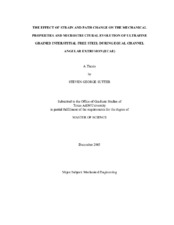| dc.description.abstract | The objectives of this study were to examine the effect of strain and path change on
the microstructural evolution of ultrafine grained interstitial free (IF) steel during equal
channel angular extrusion (ECAE); to determine the mechanical properties; to observe
the resulting texture; and to perform optical and electron microscopy of the resulting
material. The effects of different routes of extrusion (A, B, C, C' and E), heat treatment
and plastic strains from 1.15 to 18.4 were examined. Monotonous tensile testing was
used to determine mechanical behavior of processed materials. X-ray diffraction and
TEM analyses were performed to evaluate the effect of processing on texture and grain
morphology. Hardness measurements were performed to determine recrystallization
behavior of the processed material. Optical microscopy was conducted on heat treated
samples to determine their grain size and refinement.
Monotonous tensile testing of processed materials showed that there was significant
strengthening after the first extrusion. Further processing resulted in increasing values of yield strength and ultimate tensile strength, with ductility at failure varying depending
upon which processing route was used. The best tensile strength results were obtained
after processing Routes 8C' and 16E, due to the significant grain refinement these routes
produced.
X-ray diffraction revealed increases in strength of preferred texture along the
directions [111] and [001], perpendicular to the transverse plane, for all specimens that
were processed using ECAE. TEM observations showed a consistent refinement of
grain size as the amount of processing increased, especially within Routes C' and E.
Hardness measurements of heat treated specimens showed that the onset of
recrystallization occurred at approximately the same temperature of recrystallization as
that of pure iron, 450°C. The recrystallization curves for all samples showed that grain
growth begins at a temperature of around 700°C.
The low carbon content of IF steel made optical microscopy challenging. The grain
size of annealed materials becomes finer and more uniform, ranging between 60 and 90
μm2, at high strain levels under Routes C' and E, due to the many potential nucleation
sites developed in highly worked material. | en |


